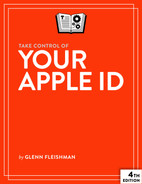Understand Your Apple ID
Your Apple ID acts as a sort of informational and financial clearinghouse for all the ways in which you interact with Apple’s hardware, apps, and services. As a result, it sometimes feels like 20 pounds of flour crammed into a 5-pound sack.
Fundamentally, Apple IDs are usernames with passwords attached, but because they’re used in so many different ways, they’ve accrued a lot of disparate data and responsibilities. You see this as a user in the Apple ecosystem. You have to enter your Apple ID and password over and over (and over) again, because Apple oddly doesn’t let you establish and manage your Apple ID identity in one place and then apply it across all its services and apps, especially in macOS. Every service seems to have its own login dialog and procedure.
In this chapter, I introduce how the Apple ID evolved, what the credentials are used for, and all the many places in which you might be called upon to enter one.
What’s an Apple ID?
An Apple ID account always comprises two parts: a username that’s in the form of an email address, which is also the primary way for Apple to reach you; and something that authenticates you—a way to prove you’re the valid holder of the account.
While an Apple ID can have multiple email addresses associated with it, for backup communications and rescue purposes, it only has a single password associated with it.
Depending on the way your account is set up, authentication may be through a password or a password plus a login token. I explain how login tokens work in Authenticate Your Apple ID Login.
From a Murky Past, Apple ID Emerged
Long-time Mac users will remember that Apple started offering cloud-based services many years ago, before the term cloud began to mean “a bunch of servers that appear like one entity and I don’t know where any of the hardware is.”
Apple started its internet-based offerings under the name iTools in 2000, not long after Steve Jobs resumed control of his company (Figure 3). It included some online storage and let you host a website.
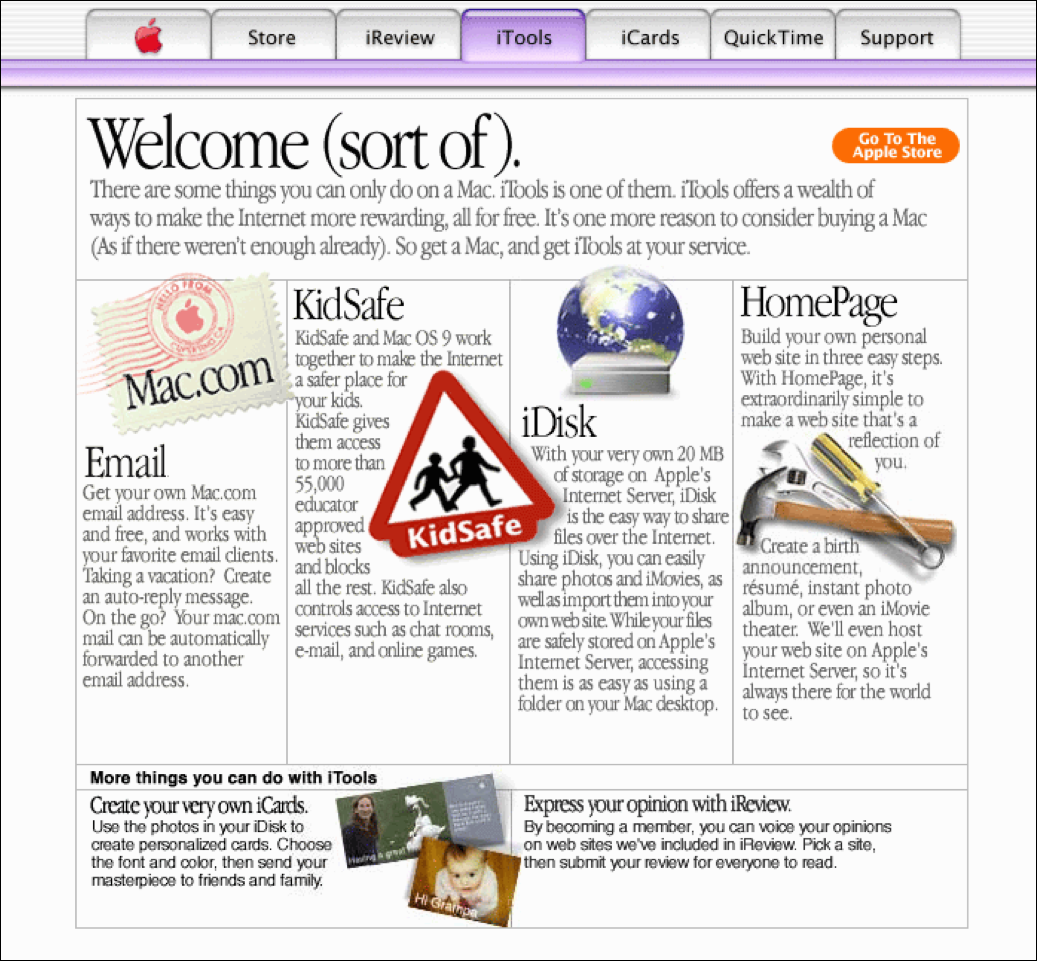
iTools also let users claim a unique account name—one that for many of us persists as at least one of our Apple IDs! A friend registered my iTools name in Seattle while I was at the Apple keynote in San Francisco listening to Jobs introduce the system. (Thanks, Geoff!)
iTools morphed into .Mac in 2002. This service increased storage and added email and other features. It expanded to become MobileMe in 2008, with email, contacts, and calendar updates and syncing friendlier to the iPhone (Figure 4).
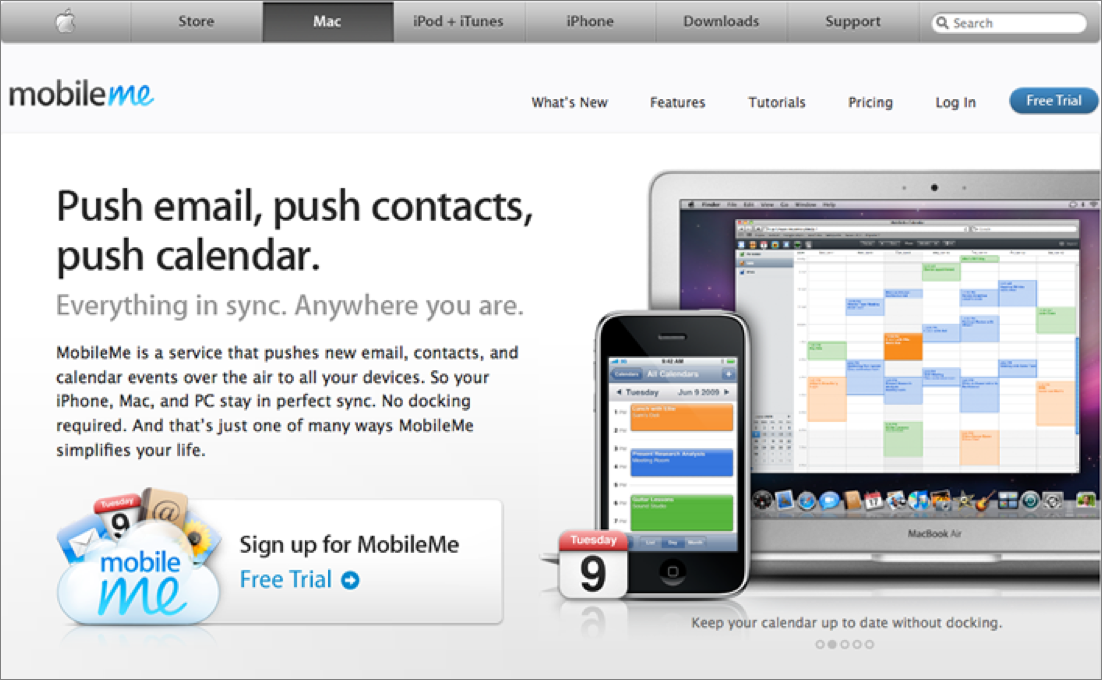
Apple settled on the name iCloud in 2011. This service became a superset of everything that a user stores or syncs across devices or exclusively in the cloud: events, contacts, email, photos, and music. It’s also regular old cloud storage in the form of iCloud Drive. Third-party apps can use iCloud for sync and storage as well.
While Apple expanded and renamed its cloud services, it also added iTunes purchases, starting in 2003. However, you couldn’t buy stuff in iTunes using your preexisting .Mac account. You had to set up an iTunes account to make purchases—and if you didn’t use your .Mac email address to set up your iTunes account, now you had two different Apple accounts. The iTunes-based account eventually became the way to identify yourself in Apple’s online stores, including its hardware and software store, and in Apple apps in Android and Windows.
This history is why many of us who have been in the Apple world for a long while have two Apple IDs: Apple effectively migrated all its cloud-services accounts and its store accounts to the same Apple ID system. However, if you used an email address other than your mac.com address, you wound up with two Apple IDs. Apple never gave us an opportunity to merge information. That continues to haunt them (and us), and is part of the reason this book exists.
Where does Apple ID fit into this? An Apple ID has never managed anything in the cloud, but it evolved from both a cloud services account and a purchasing account to be your key to everything you sync or store with Apple and purchase from Apple. An Apple ID is really just a username with a password attached.
How Apple Uses the Apple ID
Apple uses Apple IDs as the ownership credentials for a host of different kinds of data, behavior, and commerce. The notion of the Apple ID gets commingled with iCloud, because that single ID is also used to link up most of your iCloud behavior.
Let’s look first at how Apple uses Apple ID, and then at the difference between an Apple ID and its iCloud ecosystem.
One Account, Many Uses
My goodness, but Apple relies on the Apple ID for a lot of different purposes, only some iCloud related. This is as complete a list as I’ve come up with, but I wouldn’t be surprised if I missed nooks and crannies:
iCloud sync: iCloud syncs contacts, calendar, photos, and music—whether personally recorded, ripped locally, or purchased in unlocked form from another store (Figure 5). Some kinds of sync require a separate subscription or may require iCloud+.
Email: If you have a mac.com, me.com, or icloud.com Apple ID, your Apple ID effectively doubles as an email address accessible from iCloud.com (the website and associated mail services).
Storage: iCloud Drive as well as Apple and third-party apps that use iCloud storage are associated with your Apple ID, too. This includes home security camera video snippets if you use HomeKit Secure Video. You can manage storage and make payments for storage using details stored in an Apple ID account.
Purchases: Your Apple ID records purchases at the iTunes Store, App Stores, and Apple.com. You also use your Apple ID to make purchases on devices, such as in-app purchases in iOS and iPadOS, and movie/TV purchases and rentals on an Apple TV.
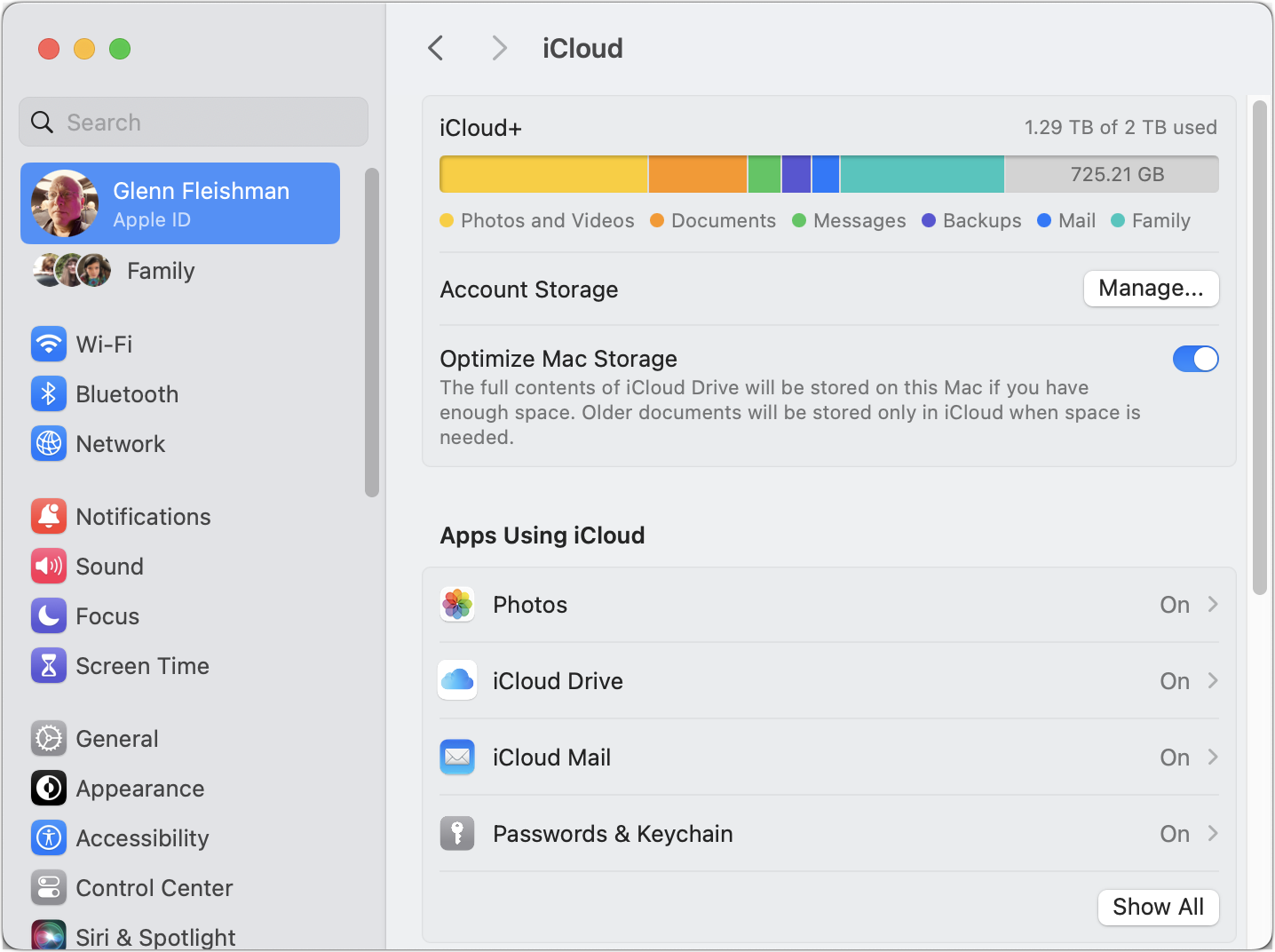
Figure 5: The iCloud view in macOS System Settings (Sonoma shown here) is one of many locations where you can manage aspects associated with an Apple ID. Subscriptions: Your iTunes Match, Apple Music (in iOS, iPadOS, macOS, Android, and Windows), Arcade, News+, Apple TV+, Fitness+, Apple One, and iCloud storage subscriptions are all linked to your Apple ID. For more on the many subscriptions now offered and how to manage them, see Subscribe to Services.
Family Sharing: Apple ties its option to share media and app purchases, subscriptions, in-app purchases, pooled iCloud data, and device location as a grouped set of Apple IDs. I delve into the topic in Share with Your Family.
macOS FileVault: Apple optionally lets you store a macOS FileVault recovery key in iCloud, locked with your Apple ID.
Find My item sharing: Starting in iOS 17/iPadOS 17 and Sonoma, you can share access to each of your AirTags or third-party Find My tracking items with other people via their iCloud account.
Account Recovery: iCloud can be used for three kinds of account recovery: personal (with a code) and via a trusted person (to recover synced data), shown in Figure 6; and after your passing (to allow family or an estate manager to access your information), accessible via a special website. See Recover Your Account.
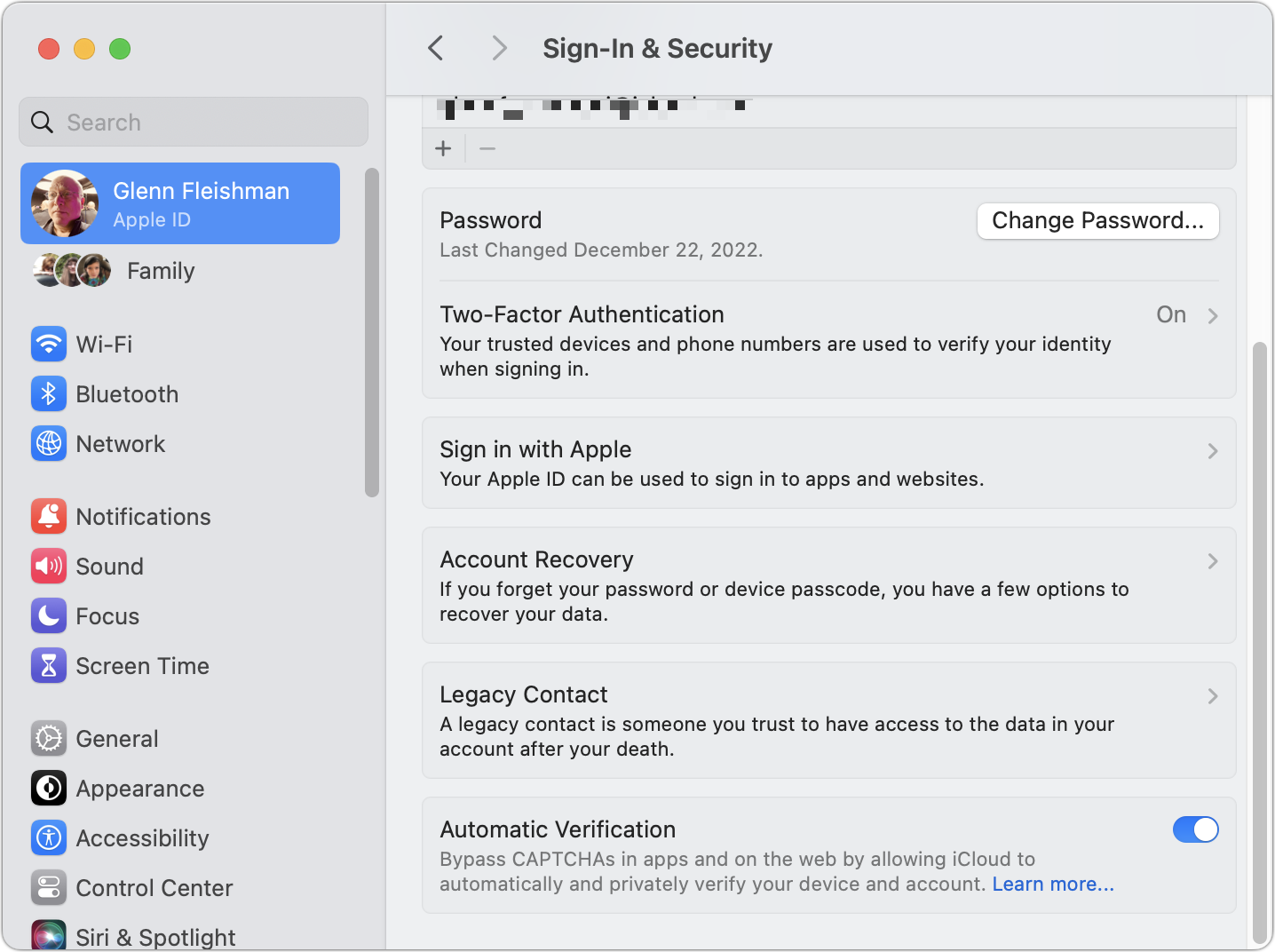
Figure 6: Apple locates its recovery options in Sonoma in System Settings > Account Name > Sign-In & Security. macOS login: You can link a macOS account with iCloud using an Apple ID so you can log in even if you’ve forgotten your password in macOS.
iOS and iPadOS Backups: Access to backups stored at iCloud rely on an Apple ID login.
Movies Anywhere: Apple is part of the Movies Anywhere service, which links digital purchases from several film studios: Disney, 20th Century Fox, Sony Pictures, Universal, and Warner Bros. Your Apple ID can be connected to a Movies Anywhere login, giving you access to movies from all those studios on your Apple devices.
Apple business relationships: If you’re an app developer, post podcasts, connect your site with Apple News, or engage in other business arrangements with Apple, an Apple ID is your account key for them, too.
Legacy: At one point, mac.com and me.com addresses (thus Apple IDs during some of that time) were used with AOL Instant Messenger (AIM), which has been discontinued.
How iCloud Services Fit Inside an Apple ID
You may naturally be confused about how the email address associated with your Apple ID (the address you use to login) differs both from what Apple calls an “iCloud account” and from an icloud.com email address, which you can use to send and receive mail.
An Apple ID Can Use Any Email Address
You can use any email address as the login for an Apple ID, and all Apple IDs may be used for iCloud services. However! Only an icloud.com address (and legacy mac.com and me.com addresses) can send and receive email via iCloud. (That may be obvious, but I still find it confusing as I write these words.)
At one point, when it was more difficult to obtain an unfettered email address, Apple pushed the availability of mac.com, me.com, and icloud.com addresses for .Mac, MobileMe, and iCloud in succession. That’s not an issue these days.
New users or those trying to create a new Apple ID can still get an icloud.com address so long as the account is created using macOS, iOS, or iPadOS. During Apple ID setup, you’re asked for an email address. At that point, you can opt to use an existing address or have Apple create one for you at icloud.com. That address then becomes both an Apple ID and an iCloud email address.
Apple Limits Changes to Apple IDs Using iCloud Addresses
Apple has a particular policy about using icloud.com (and preceding mac.com and me.com) addresses as an Apple ID:
If your Apple ID’s username ends in icloud.com, me.com, or mac.com, you can only change the account to another icloud.com, me.com, or mac.com address. That address has to already be associated with your Apple ID account as an additional address.
If you use a non-Apple cloud-service email address:
You can change the username to any other non-Apple address.
You can also change it to one that ends in icloud.com, me.com, or mac.com. However, if you make that change you can never return to a non-Apple address!
Apple offers excruciating detail about this at a support note.
Manage Payments with Your Apple ID
There’s one final piece of an Apple ID that can often trip people up. Apple can associate one or more payment methods with your account, which you can access and change in many different places across your devices and the Apple ID website.
This payment winds up being used anywhere you can make a purchase, as well as being available for Family Sharing members if you have that enabled (see Share with Your Family). The same area is where you manage your address for purchases shipped from the Apple Store.
What makes it more complicated, however, is that Apple manages and allows access to payments separately for iCloud, which includes purchases of actual Apple physical goods, and digital purchases and subscriptions if you have distinct Apple IDs for those purposes. I explain the vagaries below.
Let’s dig in first to one of the vagaries of types of Apple “cards,” and then into managing it all.
Fives Kinds of Apple Payment Sources
Apple has many, many kinds of credit and gift mechanisms you may encounter that stored for payment and used to make purchases. Here’s the rundown, which vary depending on your country:
Apple Card (United States only): Apple’s branded cash-back credit card (a MasterCard, issued by Goldman Sachs) will earn you 3% cash back on digital and physical purchases from Apple and a few partners, like Duane Reade and Ace Hardware. The card otherwise offers 2% cash back when used with Apple Pay, and 1% for other transactions. Starting with iOS 16.4, you can also set up a high-yield savings account if you have an Apple Card, depositing up to $250,000.
Apple Cash (United States only): You can use Apple Cash to send and receive money from other people and pay for things at Apple. Apple rebates money earned from their Apple Card to your Apple Cash balance (or, optionally, to an Apple Card savings account). If you have Apple Cash active, it appears in any of the places where you can view (but not change) your online payment methods. (Starting in iOS 17, you can set up recurring payments that use Apple Cash.
Apple Account: The Apple Account is your balance (which can be as low as $0.00) for all digital goods, including iCloud+, Apple One, and other subscriptions. It appears anywhere you can add or change payment methods—but not where you can view payment! The Apple Account balance can also be used for retail Apple Store purchases made either via the website or the Apple Store app. (You can buy stuff in physical Apple Stores with that app, but can’t use it to provide payment to a staffer.)
Apple Store Gift Card: Apple has a retail-only gift card option (explained on this webpage under the Apple Store Gift Cards heading), which can be used for retail purchases of physical goods via apple.com, the Apple Store app, and in-person stores. It works like a credit card, but cannot be used to pay for any digital goods! (In a few countries, you can’t use these cards for apple.com purchases.) Apple issues these gift cards for trade-in balances on hardware you hand over, and people can purchase them to give to others.
App Store & iTunes Gift Card: Not content to have a retail-only gift card, Apple also offers a digital-goods gift card, which can be redeemed and added to your Apple Account balance.
Apple Gift Card: Holy mackerel, am I telling you there’s another kind of gift card from Apple? Yes. Yes, I am. Unlike the Apple Store Gift Card, the Apple Gift Card—available for a limited number of countries—can be redeemed for any kind of Apple purchase. With the code in hand, you can redeem it either for digital purchases or subscriptions, or retail purchases. Once redeemed, the balance transfers to that kind of account. However, you can refill an Apple Gift Card and then redeem its new balance again at any Apple store.
Apple Pay: And there’s one more—but it’s not a card. Instead, anywhere you can pay via Apple Pay across Apple’s hardware, you can use any payment method added to Apple Pay on your individual device (or synced via iCloud). That includes an Apple Card or Apple Cash balance. Payment methods stored for your Apple ID and in Safari are distinct from these Apple Pay-enrolled items!
Sure, this is kind of a mess, but at least it’s not easy to understand (?).
Add or Change Payment Methods
Apple lets you add a payment method, or change one (including deleting it) only in Settings in iOS/iPadOS and in the App Store in macOS. You can’t make payment changes in mobile apps, macOS preference panes, or on the Apple ID website. (Why? Who knows.)
Here are the various places where you can add and modify what payment methods are used.
Manage Payment in iOS/iPadOS
In iOS/iPadOS, you have two separate places you can manage payments, although they show slightly different sets of information. If you have separate Apple IDs for iCloud and for purchases, the payment methods will also appear uniquely for those Apple IDs in each location.
For iCloud payments, go to Settings > Account Name where Payment & Shipping shows the name of your currently selected payment method, like Apple Card. Tap Payment & Shipping to see all associated payment methods, including Apple Cash if active (Figure 7).
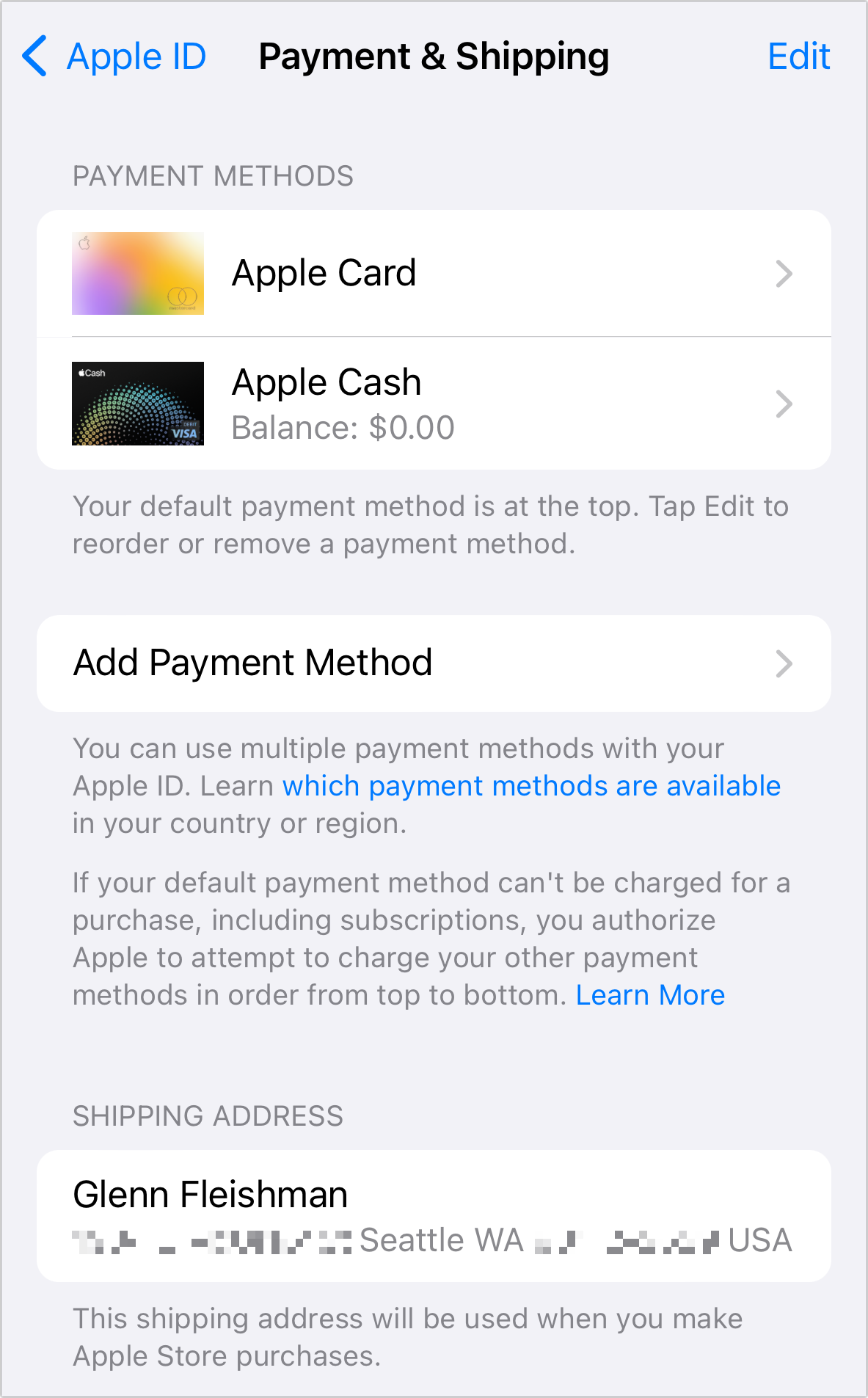
For digital purchases and subscriptions, tap Media & Purchases > View Account > Manage Payments. Your Apple Account balance is displayed here if it’s above $0.00 (Figure 8).
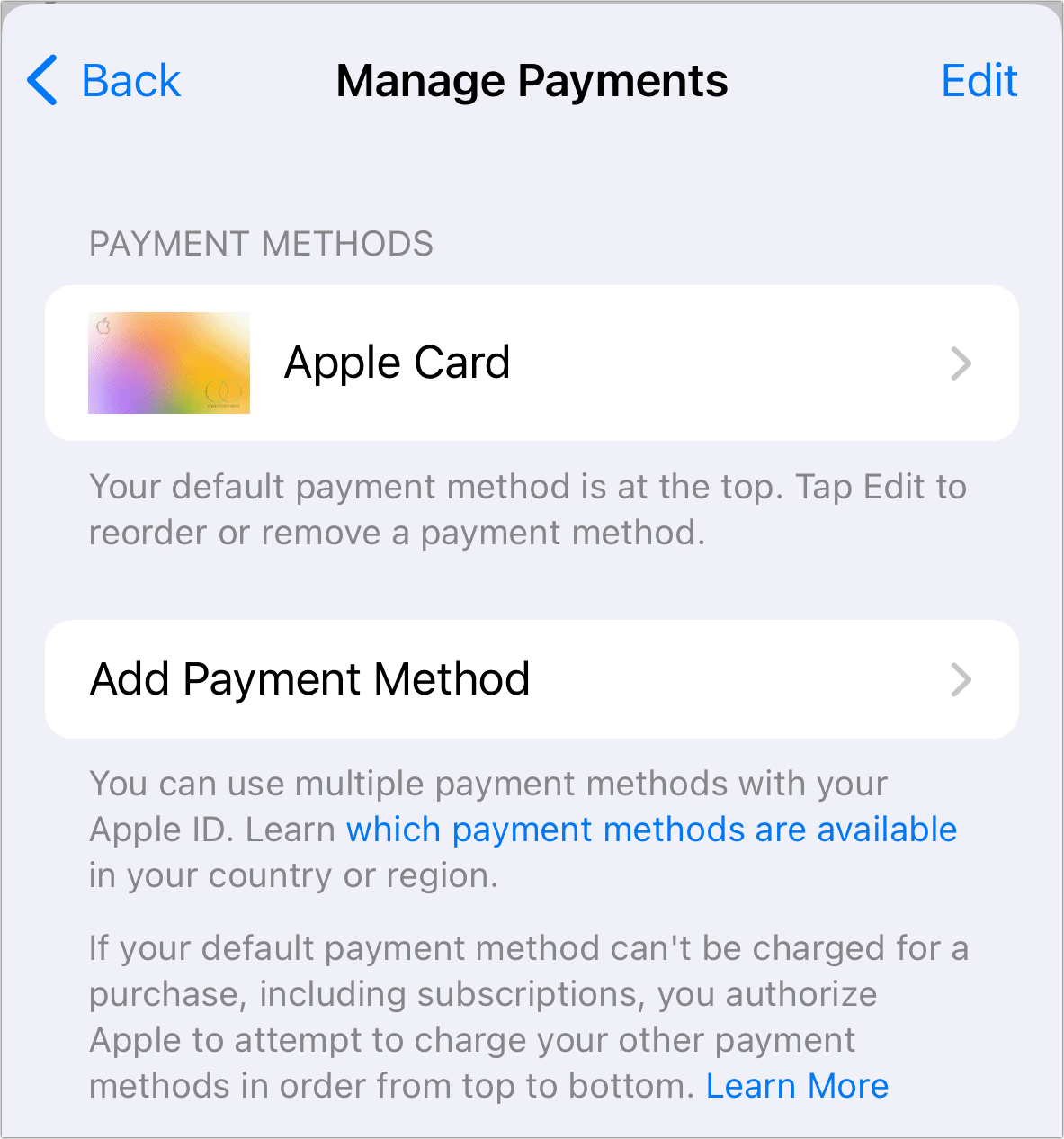
Tap Edit to remove or change priority. Apple draws payments in the order in which methods appear. With iCloud-related payments, that always starts with an Apple Account balance. You can tap a payment method, then tap Remove Payment Method Name, and confirm to remove it.
Tap Add Payment Method to do just that (Figure 9). You can choose among available payment types and enter associated details, then click Done. Apple adds it once they verify the details.
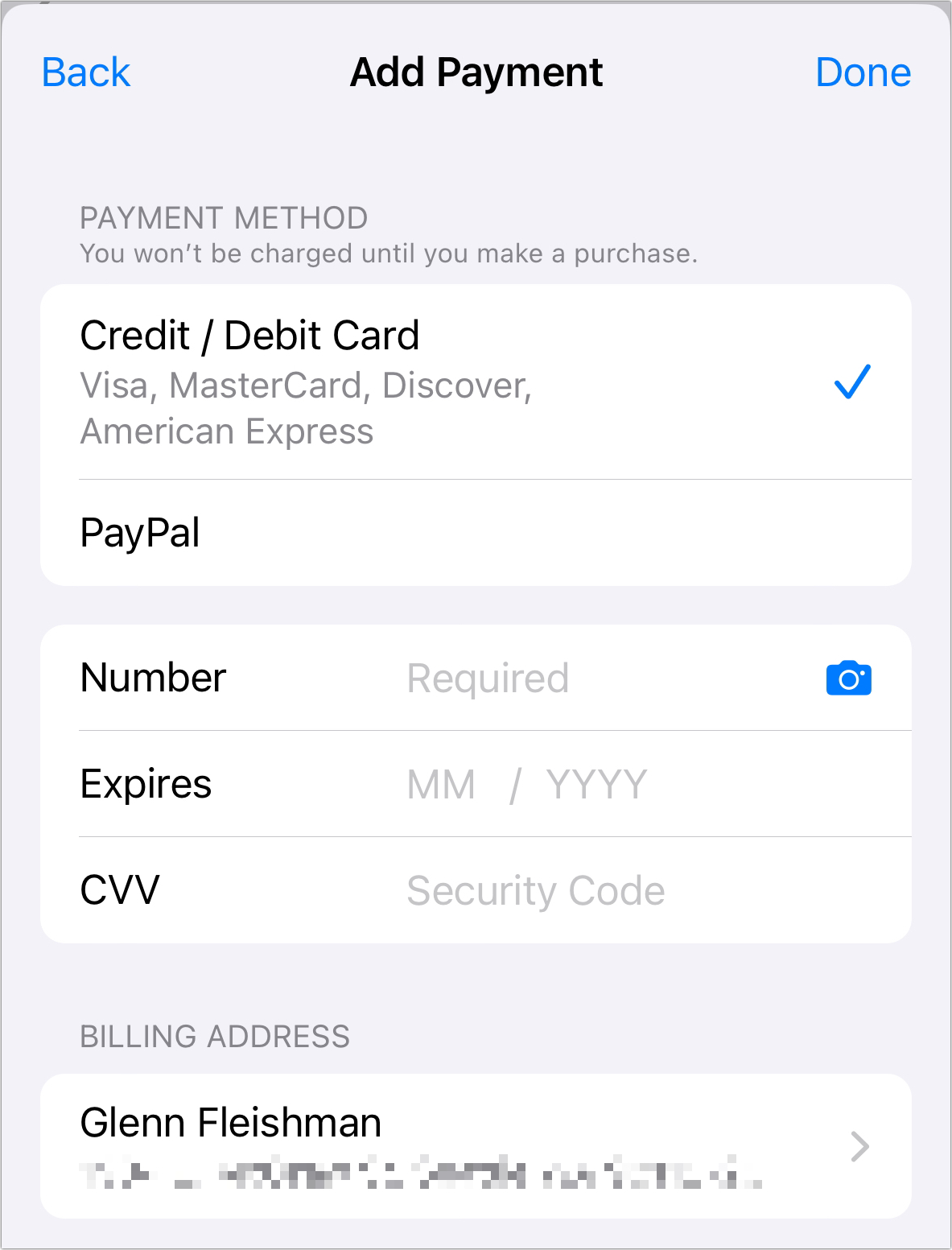
In Payment & Shipping, you can tap your name below the Shipping Address label to modify where physical items are sent, or to delete the stored address.
Manage Payment Methods in macOS
In every version of macOS released in the last several years, macOS offers the same Manage Payment interface no matter how you reach it.
However, macOS lacks a mechanism to let you manage payments for separate iCloud and purchase accounts. While you can view the payment methods and some balances in macOS—see View Payment Methods and Some Balances just below—you can modify only digital purchase and service payment methods, not ones used with iCloud and for Apple retail purchases.
To access digital purchase-associated payments, you can use any of these apps, which will show your Apple Account balance:
In the Music app, choose Account > Account Settings and click Manage Payments (Figure 10).
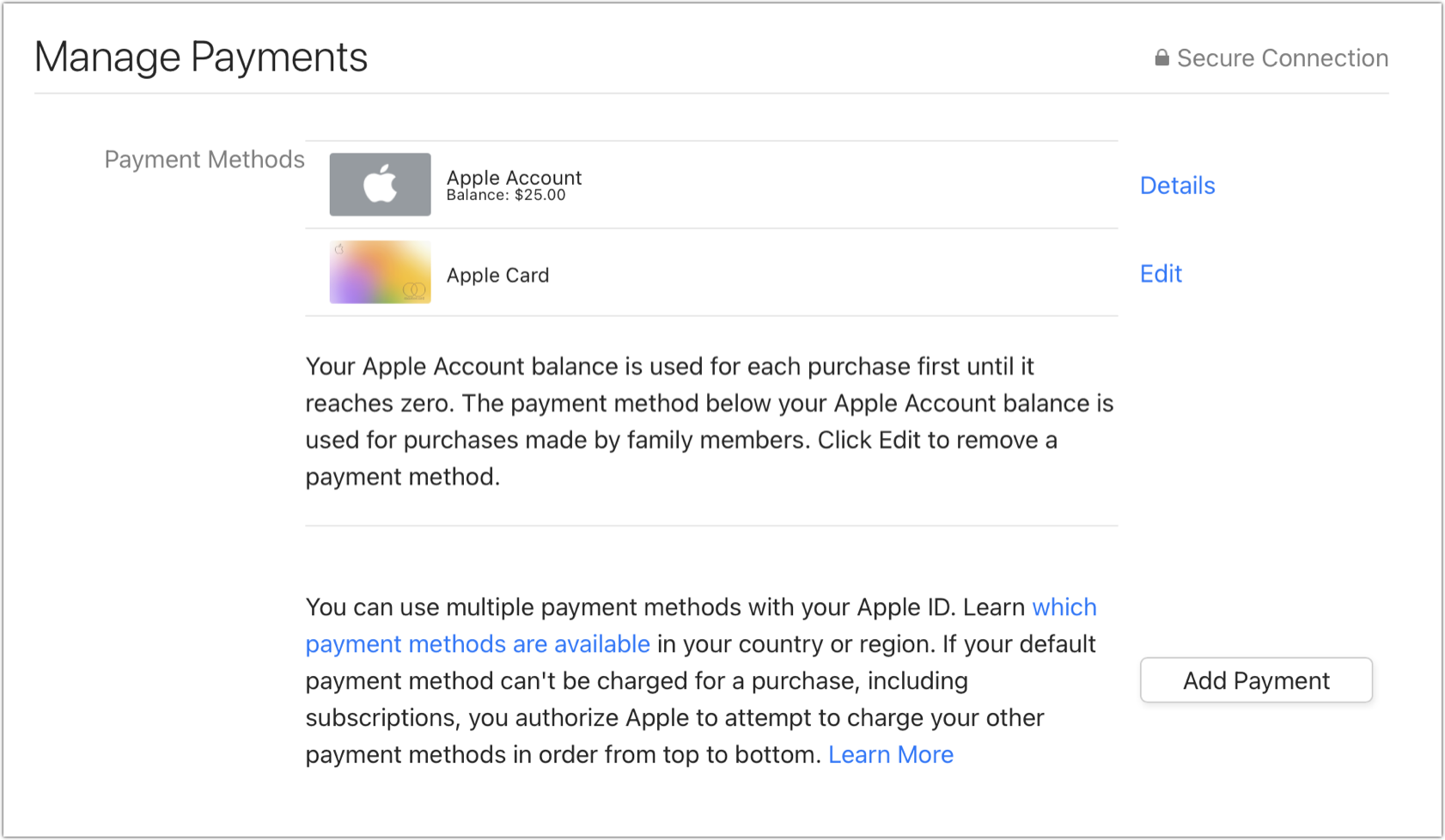
Figure 10: Manage your payment methods for digital purchases and subscriptions here and in several other places in macOS. In the App Store, choose Store > Account and click Account Settings. Then click Manage Payments.
In the TV app, choose Account > Account Settings and click Manage Payments.
In each of these places (and potentially more that I missed), you can see a list of stored payment methods. Click Delete to remove, Edit to modify the country of the card and its billing address, and Add Payment to add another method as in iOS or iPadOS. In some apps, you can click a camera icon to capture a card number and other data instead of entering it by hand.
View Payment Methods and Some Balances
Apple also lets you view the active payment method, change its billing address (including country), and change your Apple Store shipping address even though you can’t modify the payment method. You can also view your Apple Card balance and your available Apple Cash.
Go to System Preferences > Apple ID (Monterey) or System Settings > Account Name (Ventura or later) and click Payment & Shipping. Click Details to change the billing address for cards other than an Apple Card; click Edit to change the shipping address (Figure 11).

You can instead visit the Apple ID website and, after logging in, click Payment Methods; click View Details, which opens a separate window in which you can make billing and shipping address changes.
iOS and iPadOS lack a way to just view balances. The two options for iCloud and purchases in Settings > Account Name both let you manage payments, although the main view for Media & Purchases shows your Apple Account balance as just “Balance.”
